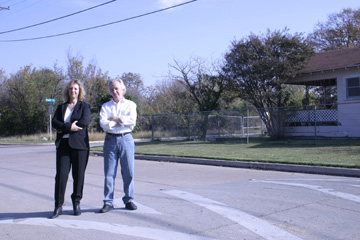 The switch has appeased many Southside homeowners, but the end result may be to move potential drilling sites closer to schools and areas where homes are rented, not owned. Activists in the Berkeley Place, Ryan Place, and Mistletoe Heights areas mounted a strong grassroots campaign to alert their neighbors that signing leases for mineral rights in their densely populated neighborhoods could have major long-term detrimental effects on their quality of life. “We just tried to get people to understand that having hundreds of water trucks coming into our neighborhoods would destroy our streets, clog our traffic, and make our lives miserable,” said attorney Liane Janovsky, a leading activist against urban drilling. “And then there is the issue of potential danger if one of those wells explodes. Why would we expose ourselves to that? For what? A few dollars in bonus money and maybe a few dollars a month in royalties? It has never made any sense to me.”
The switch has appeased many Southside homeowners, but the end result may be to move potential drilling sites closer to schools and areas where homes are rented, not owned. Activists in the Berkeley Place, Ryan Place, and Mistletoe Heights areas mounted a strong grassroots campaign to alert their neighbors that signing leases for mineral rights in their densely populated neighborhoods could have major long-term detrimental effects on their quality of life. “We just tried to get people to understand that having hundreds of water trucks coming into our neighborhoods would destroy our streets, clog our traffic, and make our lives miserable,” said attorney Liane Janovsky, a leading activist against urban drilling. “And then there is the issue of potential danger if one of those wells explodes. Why would we expose ourselves to that? For what? A few dollars in bonus money and maybe a few dollars a month in royalties? It has never made any sense to me.”
Janovsky, who lives in Ryan Place, and others, like Susan Wade from Berkeley Place and Don Young, who lives in West Meadowbrook but has worked with Janovsky and Wade, got their neighbors’ ears: If enough of them didn’t sign leases, the gas companies couldn’t drill. But XTO and Chesapeake, the two major players in the area, were having none of it. To counter activists’ pleas, they simply upped the ante. Gas companies were initially offering $2,500 an acre in bonus money; when their landmen couldn’t get leases signed, the price was raised, and by early fall reached a whopping $15,000. “That just dazzled a lot of people,” said Janovsky. “In reality they might only have a sixth of an acre so they’ll only be getting $2,500, but people just found it irresistible. Ryan Place is still in play, and it’s not a done deal yet, so I’m not resigned, but there has been a tilt toward drilling.”
Wade agreed. “I suspect it’s almost a done deal in Berkeley that the gas companies have enough signatures to start drilling because of the bonus money increase,” she said. Janovsky thinks the historic neighborhoods got the big bonus money because they were the first organized opposition the gas companies had to face. “We were their first bump in the road,” she said, “and if you can water down the opposition by paying off the people — with the big bonuses — to have them lose interest in coming to meetings, well, obviously that’s a strategy that they think will work for them.” XTO offered more incentives. The company, which had long coveted the rights to a potential drilling site in the rail yards at Eighth Avenue and Elizabeth Boulevard — right behind the Berkeley Place neighborhood and directly across the street from the gates to the Ryan Place neighborhood — has promised they will never drill within 600 feet of Berkeley’s borders. “Which means they can never use that site,” said Wade, “even if they could acquire it and get a high-impact variance from the city council that would permit it.”
In addition to putting the 600-foot clause in their Berkeley leases, XTO agreed to light and sound restrictions in many leases, which presumably will minimize the company’s impact on the homeowners when they do drill. While those clauses sound reasonable, Janovsky said residents shouldn’t be taken in by them. “The alternative site XTO wants to use is just off Hemphill at Page and Jennings,” she said. “That is within 1,000 feet of the Fort Worth ISD’s Daggett Montessori school, as well as Daggett Elementary and [Daggett] Middle School and the Montessori preschool. There are also a couple of dozen poor rental properties over there. And I object to the idea of a gas well that close to schools.”
Janovsky said that when she argued that point at a September meeting with XTO representatives, their response was that “trains carrying hazardous materials were already passing near the schools, so the gas well wouldn’t really be adding anything new. I found that incredulous — compounding an existing problem with additional potential dangers is absolutely adding something new to the mix. Why would you or I or anyone want to put our kids further into harm’s way than they already are?” She pointed out that a Sept. 13 explosion at a natural gas facility in Hood County shattered windows 400 yards from the site. She also said that, now that XTO has promised not to go after the Eighth Avenue site, lease signers may be seen as “NIMBYs who aren’t against urban gas drilling, just opposed to it in their back yard.” And the Eighth Avenue site is not completely off the board. Chesapeake apparently still wants it, or it might wind up going to another company altogether.
“At meetings with city officials and gas company representatives, we were told over and over again that urban gas drilling has been done in many areas,” Wade said. “And we were told by the gas companies that the Fort Worth area would be drilled using the Long Beach, Calif., model. But I contacted Long Beach, and it turns out that wells have only been drilled in industrial areas there, that there has only been drilling for oil, and that the last re-drill of a well occurred 24 years ago. So we are simply being lied to.” Don Young, who operates the Fort Worth Citizens Against Neighborhood Drilling Ordinance (fwcando.org) web site, is another who thinks big bonus bucks have tipped the scales enough to give a green light to gas drilling on the South Side. “I’ve not totally given up on the South Side — how can you not be concerned about a drill site so close to schools off Hemphill? But I’m focusing my attention on other areas. Liane [Janovsky] and I are definitely working to line up votes against high-impact well variances.”
The city’s drilling ordinance requires that gas wells be no closer than 600 feet from homes, churches, hospitals, and schools, but gas companies can petition for exceptions to that. To drill closer, they must request a “high-impact variance” from the city council, which then determines whether the benefits of the well outweigh its risks to the nearby populace.
Young also pointed out that a gas company — he and others believe it is Chesapeake — wants to drill just south of the beautiful old Texas & Pacific warehouse on Lancaster Avenue, which is going to be developed for high-end condos. “I went by it a few days ago, and the well-pad site has been staked out,” he said. The site is roughly 170 feet from those future condos and only 240 feet from I-30 and other historic buildings. “That’s about as downtown as you can get,” he said. “And if something goes wrong on a site like that, well, you’ll have a catastrophe on your hands.”
A Chesapeake official spoke briefly to Fort Worth Weekly for this story but did respond to questions by press time.
Outgoing city council member Wendy Davis said she could not comment directly on the site “because of ongoing legal questions being discussed by our legal department concerning that site. The issue is whether a well drilled in an area zoned for mixed use would require a high-impact variance to be located so closely to a residential site.” She said she thinks such a variance would be required because of the planned condos. Davis said she does not believe it’s out of the question that the gas company that’s considering the site — she would not say which one it is — would jump the gun by starting to drill immediately, in order to get the work done before the condos fill up with people and the special variance becomes a factor. “And I can’t predict whether my attempt to slow that down will be effective.”
Young is also worried about a new potential problem revealed in stories published this week by the Denton Record-Chronicle and The Dallas Morning News. The four-part series explains that naturally occurring radioactive material is being brought to the surface by gas drilling. Thus far, reporter Peggy Heinkle-Wolfe wrote, “two decontamination companies have cleaned up 25 Barnett Shale sites of about 1,000 barrels of radioactive waste in the past two years.” The material often accumulates on pipes, and while low doses are not likely to have a harmful effect on humans, the idea of such radioactive waste accumulating in urban areas is raising more red flags about urban drilling — or at least that’s what Young hopes.
“When you add it all up — the noise, traffic, ruined streets, safety issues,” Young said, “… well, you’d think people would come to the conclusion that urban drilling simply isn’t in their interests — regardless of a couple of dollars in bonus money.”











